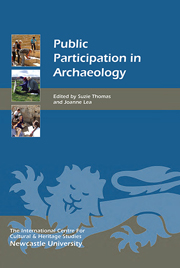Book contents
- Frontmatter
- Dedication
- Contents
- List of Illustrations
- Acknowledgments
- List of Abbreviations
- Preface
- Introduction
- Public Participation in Archaeology: International Models
- Public Participation in Archaeology Through Education
- 6 Accessing Archaeology in the School System: Powerful Partnerships — a Case Study of the Challenges and Rewards for Archaeologists, Teachers and Students (Canada)
- 7 Hook 'em When They're Young: Using Enquiry-Based Learning Workshops in Archaeology
- 8 Archaeology as Culturally Relevant Science Education: The Poplar Forest Slave Cabin
- 9 Heritage Education in Jordanian Schools: For Knowledge or Profit?
- Public Participation in Archaeology Through Tourism
- Public Participation in Archaeology Through Site Management and conservation
- List of Contributors
- Index
6 - Accessing Archaeology in the School System: Powerful Partnerships — a Case Study of the Challenges and Rewards for Archaeologists, Teachers and Students (Canada)
from Public Participation in Archaeology Through Education
Published online by Cambridge University Press: 05 August 2014
- Frontmatter
- Dedication
- Contents
- List of Illustrations
- Acknowledgments
- List of Abbreviations
- Preface
- Introduction
- Public Participation in Archaeology: International Models
- Public Participation in Archaeology Through Education
- 6 Accessing Archaeology in the School System: Powerful Partnerships — a Case Study of the Challenges and Rewards for Archaeologists, Teachers and Students (Canada)
- 7 Hook 'em When They're Young: Using Enquiry-Based Learning Workshops in Archaeology
- 8 Archaeology as Culturally Relevant Science Education: The Poplar Forest Slave Cabin
- 9 Heritage Education in Jordanian Schools: For Knowledge or Profit?
- Public Participation in Archaeology Through Tourism
- Public Participation in Archaeology Through Site Management and conservation
- List of Contributors
- Index
Summary
My first experience of archaeology education began with a day-long field trip to Sainte Marie-among-the-Hurons, a recreated 17th-century Jesuit mission in Ontario, Canada. Originally, I thought of the visit as a reward for diligent students in my ‘Ancient Civilisations’ secondary school course. Fortunately, it turned out to be an ideal opportunity for us to learn outside the walls of the traditional classroom. From that humble beginning evolved a completely revised, fully accredited high school course in archaeology and, most recently, a board-wide programme in archaeology for elementary school students. It would not have happened without developing powerful partnerships. This case study of that high school credit course serves to illustrate to archaeologists how to develop and maintain those partnerships with educators that facilitate public participation in archaeology.
The high school archaeology course is rich in critical thinking opportunities. It transforms the student by changing a young person's relationship with, and understanding of, the past. Over one hundred graduates from my secondary school course have gone on to major in archaeology as university undergraduates. Four of these graduates work with me in their capacity as professional archaeologists and as mentors to current students, and several have undertaken postgraduate studies in archaeology.
- Type
- Chapter
- Information
- Public Participation in Archaeology , pp. 73 - 80Publisher: Boydell & BrewerPrint publication year: 2014



